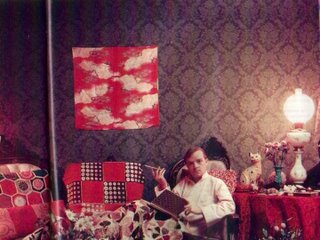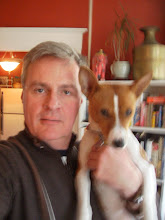Do those pressed for cash press their cash?
 I went to see Infamous, the shinny, second take on Truman Capote’s time in Kansas at the top of the shiny, second half of the Westfield San Francisco Center. If this shinier version of the story told last year in Capote is too obvious at times, at least it showed life in New York as much as it did the deaths in Kansas. There is some comfort in knowing that Daniel Craig will probably go into the history books as the first James Bond to have kissed another man on screen in at least two films -- Enduring Love being the other one that comes to mind, but there may be others.
I went to see Infamous, the shinny, second take on Truman Capote’s time in Kansas at the top of the shiny, second half of the Westfield San Francisco Center. If this shinier version of the story told last year in Capote is too obvious at times, at least it showed life in New York as much as it did the deaths in Kansas. There is some comfort in knowing that Daniel Craig will probably go into the history books as the first James Bond to have kissed another man on screen in at least two films -- Enduring Love being the other one that comes to mind, but there may be others. The opening headshots were certainly overly flashy, and much as I like Hope Davis, she just can’t evoke Slim Keith’s slimness. Sandra Bullock whom I’ve always found cloying, greatly surprised me. It was a bit disconcerting to hear the quote from Diana Vreeland qualifying that she could be perceived eccentric for having the soles of her shoes polished and ironing her money. Those are not eccentricities to me, just practical rituals that I’ve adhered to for 20 or more years without realizing that there are now two more things that I share with Diana Vreeland. However, I could add that while I once thought spray starch would give the folding tender the crispness of newly minted bills, it tends to give them a bit too much of a barbecued patina. However, one could argue that it gives the sharp gravitas of old money. Unlike Mrs. V I never had a servant do the duty for me, and somehow ironing the money sometimes proved to be a way to feel it gained some greater value by being so perfectly detailed. One thing that was not covered is how she handles her coins. I have always put quarters in one bowl, pennies in a second one and nickles and dimes in a third. Of course only an obsessive person would separate the nickles and dimes. Quarters need to be easily available for laundry and public transit, pennies aren't worth cashing in until I have at least a quart or more of them, and quarter and nickles can always be added in to the container in my car for parking meter fare. Pennies, of course, are useless for that.
The return to Holcomb, Kansas, was a arborous as ever, perhaps because the Clutters’ home looked a bit too much like the one I grew up in.
Like the Clutters we lacked a safe in the basement but had a much better hom e décor aesthetic since my mother, like Truman’s, always longed to be a Park Avenue swan and managed to live it out through tireless hours spent searching for the perfect matching wallpaper/drapery swatches and samples of field stone for the fireplace mantel.
e décor aesthetic since my mother, like Truman’s, always longed to be a Park Avenue swan and managed to live it out through tireless hours spent searching for the perfect matching wallpaper/drapery swatches and samples of field stone for the fireplace mantel.
What seems to have gone unnoticed in most reviews of this latest installment of the Capote saga is the Brooklyn Capote. It is, in fact, noted that he lived in the basement of a Brooklyn Heights brownstone, and when he moves across the river to a UN Plaza condo his view of the place that he has left behind. Perhaps someday there will be a revived interest in his 56-page opus, “A House on the Heights” that chronicles that venue on Willow Street and tries to imagine the history of that house. Having grown up in the Clutter-like house on the prairie whose history I knew from its construction in 1904 onward I  have since lived in places where I was disconnected to anyone prior to the realtors setting foot into the place. Perhaps I’m better off not knowing that history, though sometimes when I sit in the bay window I wonder if mothers sat there from the Spanish-American war onward wondering when their sons would be sent home.
have since lived in places where I was disconnected to anyone prior to the realtors setting foot into the place. Perhaps I’m better off not knowing that history, though sometimes when I sit in the bay window I wonder if mothers sat there from the Spanish-American war onward wondering when their sons would be sent home.
In Cold Blood always rang too familiar to me in its venue, and I’ve never made it through the entire book or filmed version in one sitting, not even after all of these years of being away from an isolated white house on the windswept prairie. Just when I was getting to the most gruesome parts, I could spot the headlights of a stray car in the distance. I could picture myself tied up in our basement, being offered a pillow for my head before my brains were blown out.
So I don’t take too much comfort in going back to the prairie towns with Truman to see the good people like the Clutters’ murders recreated in excruciating detail.
Then, as now, I was looking at the river but thinking of the sea. The sea, of course, being the Atlantic that was just beyond Manhattan and Brooklyn, home to far, far many more murders than Kansas. But I never thought of that, just of the swans. Years later when I was living in Brooklyn, albeit the then emerging Park Slope not the more high toned Brooklyn Heights, I had the first opportunity to first meet a donor who lived in UN Plaza. The thought always went through my mind of whether or not she was ever a neighbor, but I could never cross that bridge with this swan. I learned last week that she is moving back to Firenze, certainly the perfect pond for an aging swan to swim in. When I first met her, I had recently seen the play Tru, set entirely in his UN Plaza apartment, and I kept looking for similarities in details, the bookcases, the view out the window. There was certainly a resemblan ce, but I kept telling myself that most of the apartments probably look much the same. I’ll never know now, I guess.
ce, but I kept telling myself that most of the apartments probably look much the same. I’ll never know now, I guess.
Labels: Brooklyn, Capote, Diana Vreeland, ironing, Park Slope



0 Comments:
Post a Comment
<< Home